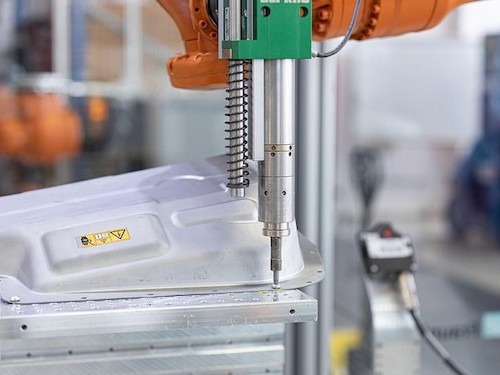Old batteries for electric cars contain valuable raw materials that can still be used.
In order to be able to recycle it, a research team from the Center for Digital Battery Cell Production (ZDB) at Fraunhofer IPA is developing a robot cell with a variety of tools. It must be able to perform all necessary disassembly steps and be suitable for all types of batteries.
The electric motor is becoming more and more important in automobiles. Last year, about 13 percent of new cars in this country were equipped with an electric motor, some paired with an internal combustion engine. There could be nearly 50 million electric cars on the world’s roads by 2030 if all the announcements came true.
This trend, due to climate change, creates a recycling problem: more and more batteries are accumulating that must be replenished. Since the battery lasts about ten years on average, the problem becomes more urgent from year to year. So a team of scientists and technicians from different institutes is looking for a way to deal with this threatening flood. The research project “Industrial Dismantling of Batteries” (DeMoBat), coordinated by the IPA Fraunhofer Institute for Manufacturing and Automation Engineering, aims to provide a comprehensive solution suitable for all work steps and battery types.
Give batteries a second life
Battery cell components should be disassembled according to type and then checked if they are still good enough for direct reuse. One day, second life batteries will be created from the components used. If the components used are no longer suitable for this, then at least their chemical components must be treated. Because used batteries contain many raw materials that can still be used, such as nickel, cobalt, manganese or lithium. To get to them, you first have to disassemble the component: lines, cables, sockets, seals, screws, battery cells, electronic components, brackets – all this must be disassembled.
Lorenz Halt of Fraunhofer IPA’s Robotic and Assistive Systems Division is responsible for this part of the research project. The challenge here: No worker, but the industrial robot has to take over the work. This is even more difficult because car batteries are not standardized. Different types of cars, even different models, have different energy storage devices. So the disassembly system must be very flexible. So Halt compares it to a Swiss army knife.
The robot screws or grinds the chassis
A table measuring 2 x 3 meters with a flexible mounting system that can firmly hold any battery as a work surface. There the robot first opens the cover by unscrewing the screws. Intelligent image processing shows it the way. But this does not always work, because after ten years of wind and weather, some screws wear out and can be loosened with more. Thanks to machine learning, the robot learns at an early stage whether it will reach its destination with a screwdriver or whether it should reach the milling cutter.
“Of course, it is also possible to grind on the spot,” researcher Halt says. “But this is not the optimal strategy because it produces metallic chips that can lead to a short circuit and eventually a fire.” Lie on the workbench in a firefighting bath.
First protester this fall
As with screws, the devil is in the details elsewhere. Halt and his team had to solve many problems and develop new tools. A type of can opener is used to break up seals. The experts involved have developed a kind of small jack to lift the individual battery cells stuck together. Creativity also requires fiddling with cables and sockets that are hard to understand.
The DeMoBat research project, which has been running for three years, is only halfway through. Interim results are promising: A first demonstrator should appear this fall. “In the future, we also want to develop solutions that make it possible to recycle recovered and still intact battery components for another life cycle and integrate them back into a new system,” declared project manager Max Weber.
Hans Weck
The article was published online by: / Doris Holler /

“Total coffee aficionado. Travel buff. Music ninja. Bacon nerd. Beeraholic.”







More Stories
Innovator in Wieselburg – ZKW with 46 patents in 4th place in the Austrian ranking in 2023
AMAG with sales and profits declining in the first quarter
Traditional FC Salzburg: Reaching old successes with a new coach?